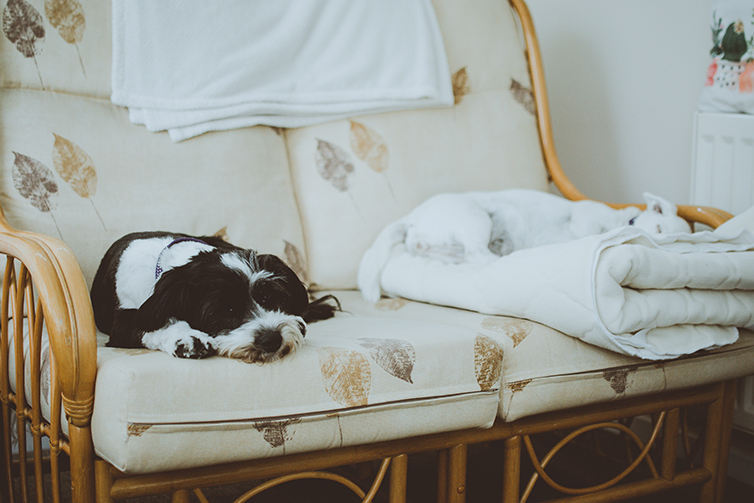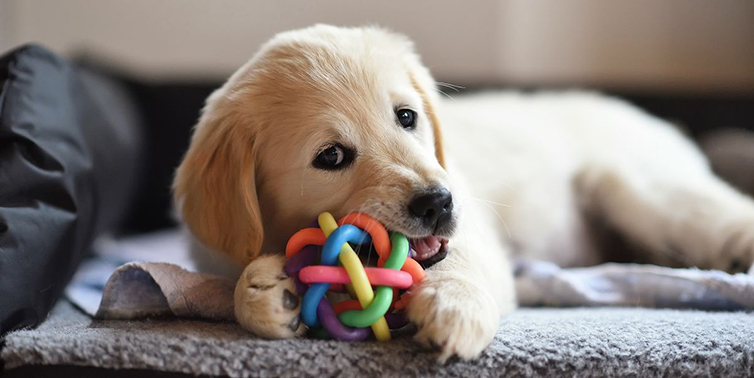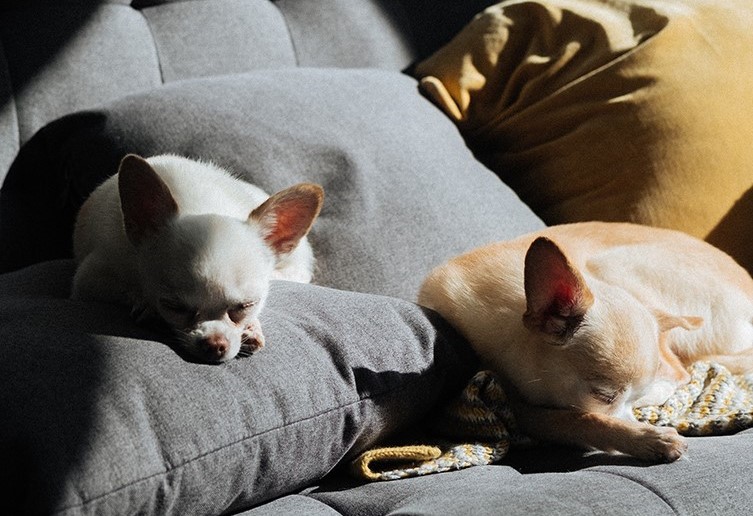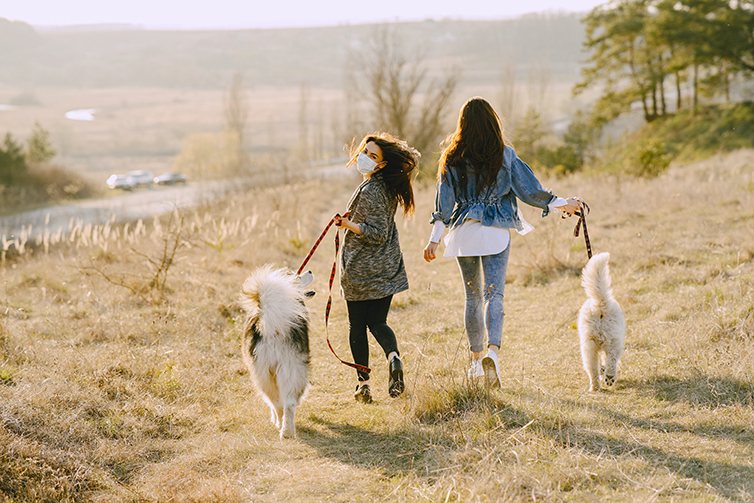All About Indoor Dogs
Bev is a single woman, working online, from home. She gets a bit lonely sometimes and has considered getting a small dog as a furry companion. But she has misgivings about keeping a dog indoors: Is it cruel? Will the dog wreck her smart apartment? How can she manage to give the doggie the exercise he/she needs? Is it selfish? How will she manage with the ‘toilet’ situation?
DOG HEALTH

Steve and Liz are a married couple, living in a small house near the city. They both go out to work. They are both animal lovers and would love to have a medium-sized dog to be part of their little family and to join them on their walks at the weekend. However, they feel that keeping a dog indoors for most of the day cannot be good for him/her, so maybe it would be better to leave it for now.
Mrs Kirby is an elderly, partially-disabled pensioner, who is struggling to cope, physically and mentally, with living alone in a flat. Her daughter, who has tried to persuade her mom to live with her, visits regularly but is worried at her mom’s increasing inability to live alone. She decides to chat to her mom about maybe getting a dog for safety and companionship reasons. Mrs Kirby is a stubborn woman and has all sorts of objections: she’s fine on her own; she can’t take care of a dog; she’ll die with no-one to take care of the dog; any dog would be bored living with her… and so on. Her daughter decides to find out more…
Andy is a young copywriter who works at an agency in town. He has a house and garden in the suburbs and a Beagle called Sniffer. He doesn’t want to leave Sniffer outside when he’s at his office because he’s heard of several dogs in his area getting stolen and he’s also afraid of the possibility of his dog escaping when the whiff of an attractive female up the road, entices him. But, at the same time, he feels that Sniffs will become frustrated, bored and neurotic locked inside the house.
Many of us are now working from home, especially during the Covid-19 pandemic; many are still going out to work; some are at home with small children; some are elderly; some are disabled in some way, some live in apartments, and there are those people who simply want to have a dog and keep him/her indoors. Whatever the reason, there are dog owners who either choose to, or have to, keep their pooch inside. There are those who might feel that this practice is cruel and that such people should not have a dog at all. Others believe that as long as any relationship is mutually beneficial (an important proviso), then there’s nothing wrong with it.
Most of these people are preventing themselves from having the joy of a furry-kid around the place (apart from Andy, who needs to make a plan), so, if you find yourself in a similar position or if you have a stay-at-home pooch already and need some advice because you can’t afford to keep replacing the furniture, then stick with this blog and we’ll try to help you answer the question…
Is it cruel to keep a dog indoors?
Well, it depends on whether you are talking about exclusively indoors (as in an apartment in the city), exclusively outdoors or, a bit of both. We’ve done the research, so let’s have a look at what some experts have to say:
What are the problems with keeping dogs exclusively indoors?
- Health Problems
Some owners may feel that they are protecting their dog from catching diseases by keeping them indoors. In fact, you can bring in bacteria when you return from a shopping trip. There will be trillions of little nasties on your shoes, on your groceries (Well… not if you sanitize them! Hands up those who conscientiously sanitize everything that comes in), and on the online order. If Rufus is kept exclusively indoors, he will not have built up sufficient immunity to bugs, so he is more at risk from infectious diseases. He can still pick up tiny beasts like fleas, ticks and mites. And some of these nasties can enjoy the comfort and warmth of your bed. #justsaying.
But, do not worry too much about these beasties, IF you have been smart enough to use vet-recommended Bravecto®. Bravecto® Chew gives 12 weeks protection against ticks and fleas and Bravecto® Spot-On provides 4 months protection against ticks and 6 months against fleas. A single dose and you can forget about it for 12 – 16 weeks, depending on the Bravecto® product you choose! Your cats too can enjoy similar benefits from Bravecto® cat range of products.
A dog who is keptexclusively indoors, like Rufus, can also become obese, due to lack of exercise and may develop diarrhoea (lovely to come home too after a hard day at the office). Rufus may also develop unhealthy intestines and may have low levels of certain vitamins which outdoor dogs develop naturally.
2. Behavioural and Emotional Problems
Most of us have seen animals, like the Big Cats, in cages (Thankfully now, in most zoos, cages are rarely seen.), pacing up and down, desperately trying to deal with the stress. Dogs kept exclusively indoors, like the caged tiger, who should have the freedom of a whole jungle, suffer from anxiety and stress, UNLESS you have taken steps to avoid the crippling boredom of dogs like Rufus, who may even be confined to one room.
The distress of such animals is usually exhibited in their behaviour. They may become destructive and restless; they may start to whine, bark, shake and bite. Obviously, no-one who loves dogs (Who doesn’t?!) would want to see their dog suffering like this. But what if the owner has no choice? Remember Bev, alone in a small apartment? And Steve and Liz, who both work?
Do not panic, doggie people. We’ll give you some suggestions later.
What are the problems with keeping a dog exclusively outdoors?
An American vet, Dr David Sewell, says:
“Dogs need to be outside for exercise and well-being. It makes them happy.”
Yes, it certainly does, but there are valid reasons why many dog owners have some problems with this.
- Weather Conditions

Generally, most of us are lucky enough to enjoy a fairly temperate climate, here in South Africa. However, we may experience an unduly hot period or freezing cold temperatures. Dogs, like us, need protection from the elements, especially when temperatures are extreme. They should not be left outside in such weather. If you have no choice but to leave your dog outside, then an insulated, waterproof kennel, which is large enough to accommodate your dog(s), is essential. A couple of dog blankets will also help to keep the cold out. They can freeze to death in cold weather or die of heatstroke in extreme temperatures. Try to position the kennel in the shade during hot weather. And it goes without saying that all dogs must have access to fresh water, 24 hours a day. Remember too that bowls of water are used up very quickly, especially in hot weather. Some bowls can also be overturned. It’s always a good idea to provide more -than-enough water at all times.
- Social Needs
Dogs are, of course, pack animals and very sociable. You and your family are their human pack. (Try to ensure that you are the leader from day one!) Even though big Gnasher is your guard dog, he should still be allowed to come inside and enjoy your company, as you can enjoy his.
And by the way, Gnasher can do his job much more effectively if he is inside the house, at least at night. How can he protect you and your family if criminals get inside and he is locked outside?
- Emotional Needs
Even though he may be outside, it is always a good idea to keep any dog stimulated to avoid boredom, which, as we have seen, can cause huge psychological problems, never mind the destruction of your property. He should have some dog toys and chews to keep him busy, just like dogs kept indoors.
- Safety Concerns
Pet theft, or ‘dognapping’, is on the rise in our country. What’s worse is the fate of the dog: puppies may be sold to puppy mills, expensive breeds are resold, and some power breeds are sold to dog fighting rings. So, this is a realistic concern for those who are deciding whether or not to keep their dog outside. There are ways of protecting your outdoor doggie:
- Sterilize your dog. This deters dog thieves, who may want to breed dogs for fighting or selling.
- Secure your property, with high fences, walls, gates, and electric fencing. This protects you, your family, your property and your dog.
- Keep your dog inside at night, as mentioned before.
- Train your dog not to accept food from strangers. It could be poisoned.
- Micro-chip your dog. This can be done at your vet, and is quick and painless. You can then report a missing/stolen dog to the microchip database. You should also report your dog missing at your nearest SAPS branch.
- Health Concerns
There are some occasions when a dog must be kept indoors. When a dog has had certain surgeries, they should be kept exclusively inside. Your vet will advise you about this. In order to heal, and to prevent further injury, dogs should be kept calm and quiet indoors. Extremes of temperature, as mentioned previously, may necessitate limiting time outdoors.
There are other possible dangers outside, including possible predators, chemicals left around, e.g. fertilizers, and let’s not forget fireworks. Whether you approve of them or not, the fact is that hundreds of dogs are severely traumatised, with many dying from their injuries, as they desperately try to ‘escape’ from the deafening (for dogs) noise, every night that fireworks are set off.
I have to keep my dog, Bruiser, inside, for various reasons. How can I help him to be happy and healthy?

O.K., let’s see if we can help you. According to our research (See sources below.), it is certainly possible to keep an indoors-only dog, happy and healthy. But you cannot just lock Bruiser in your house for possibly up to 8 hours a day and not expect trouble. Trouble here involves the possibility of: poo and wee on your floor; shredded curtains; stuffing removed from lounge suite, which are all because Bruiser became upset, bored, stressed and frustrated when you left. He took it out on your furnishings because they were the only thing available. Worst case scenario? Eventually, perhaps after a few weeks, his emotional stability may become damaged and the result may be a dog needing treatment and therapy. Physically, he may become obese or he may not want to eat at all and become anorexic. Even if you work from home or, like Bev, in her small apartment and Mrs Kirby, the lonely pensioner, you and your dog will be confined to the house for long periods of time. And, however lovely Bruiser might be, the two of you cannot sit staring at each other for hours. That is the stuff of gradual lunacy.
No-one who loves their dog wants him/her to suffer like this. How can you keep Bruiser happy and healthy inside your home, when he is alone or when you are at home too?
All living beings, whether in lockdown or not, need mental and physical activity in order to prevent and relieve stress. Toys, games and exercise will keep Bruiser mentally and physically busy, helping to keep him healthy and happy. You do not need a large garden to do this and you do not need to be physically fit either. (This is very good news for those of us who adopted sloth mode during lockdown.
ROUTINE
In unprecedented times like these, especially when we are in lockdown with kids and animals, we are all tempted to throw any routine in our lives and in our animals’ lives, out-the-window. Many of us, and our animals, have had to become indoor creatures, whether we like it or not. Animal behaviourist, Dr Annie Valuska, says that routine is very important for dogs (and, of course, for humans too) and that it is essential to maintain consistency as far as possible. We realise that keeping to a routine is often difficult, but it certainly provides structure to our lives and is psychologically essential for our well-being. So too, is it essential for dogs. And you know that they know when it’s dinner-time!
CHEW TOYS

Dogs love to chew, almost anything. In the wild, they chew the bones of carcasses to extract the nutrients. It is a natural instinct and if there is no handy carcass lying around, Bruiser, left alone, will chew what is available: your furniture. Whether you are at home or not, chewy toys and fake bones should keep him busy for a while. Be careful here though: ensure that the toys are specially made for dogs, not kids, as kids’ toys may splinter and break, possibly causing injury. You can buy tough nylon ‘bones’ and other chewable items. We suggest that you go to a reputable pet shop or your vet. If you’re not sure whether a certain ‘chewie’ is safe, ask your vet. Please do not give your dog animal bones of any kind, cooked or raw especially if you are not going to be at home. All animal bones, including hooves (Sorry!), can splinter and can cause internal injuries, possibly needing surgery.
There are some excellent toys available for dogs. There are virtually indestructible ‘food’ or ‘treat’ toys, made of heavy rubber, which have holes or pockets in them in which you can push bits of food or treats. The dog gets ‘rewarded’ for his chewing by gaining the treat. It is a self-maintaining reward system for Bruiser. The best ones are expensive, but they work and will last for years. However, Dr Severine Ligout, an animal behaviourist, says be careful not to provide too many calorie-laden treats. She suggests compensating for the extra treat calories by feeding a little less at mealtimes.
STIMULATION
If Miss D has to stay at home alone, you need to make it as stimulating as possible or she may become bored, stressed, unhappy and even destructive. You could, of course, leave chew toys and hard-to-get-at treats around the house. The more difficult (without being impossible) it is to get the treat out, the better. You may need to teach her how to use these. Dog puzzles can also be purchased, which can keep her occupied for some time. Take a look online for some ideas of what is available. We suggest that you change these toys each time you go out. Like children, dogs become bored with the same toys, however expensive!
However, there really is no substitute for a human being, even if it can’t be you. Perhaps a friend could pop in occasionally, or you could ask a dog walker to visit, breaking-up the monotony of a long day, alone? Taking Miss D for a walk before you leave will stimulate and tire her so that she may settle down more easily when you leave.

Another option – brace yourselves – is, of course, getting another dog. This may be a ridiculous suggestion for those in small apartments, but consider the fact that having some company may be all Miss Daisy needs to keep her occupied and to avoid loneliness and boredom. Who doesn’t like a bit of company?

EXERCISE
Exercise is very important for our health, both psychological and physical. (We hear you screaming: “We know, we know, we know!) It is also, of course, essential for our pets, to maintain muscle tone and for strong bones. Doggie parents in apartments; people who, for various reasons, have to keep their dog in a tiny back- yard; those who have to go out to work and leave their furry friend indoors… all of them, and us, can take our pooches out for a walk. Apart from anything else, there’s the obvious requirement for ‘pottie time’. Please remember though to take a few plastic bags with you or you’ll become the most unpopular resident in the complex, road, or apartment block. Everybody wins and it’s free!
If, for some reason, you cannot take your dog, let’s call her Miss Daisy, out yourself, maybe you could ask a friend or employ a doggie-walker. Miss Daisy will be so much happier, and so will you.
There really is no substitute for a walk for your pooch, with all the interesting/intriguing smells of dogs who have ‘left their mark’ on the pavement, but there are ways to exercise Miss Daisy and you, at home.(Not sure about Big Bruiser though…) If your home is big enough, and your dog not too huge, you could make some space and play games with her.
GAMES

Games are, of course, closely-allied with exercise and also provide often much-needed mental, and some physical, stimulation for Miss Daisy, for you and for any family members who can be dragged in (subject to Covid restrictions/protocols).
You could work on her obedience training indoors. Obeying (or not!) simple commands such as: Sit! Stay! Give me a paw! Lie down! will give both you and Miss Daisy the opportunity to have fun and to bond. You could plan an obstacle course in your house using household objects, old boxes, chairs, and so on, for your poochie to crawl through. If Miss Daisy can’t make it, it really doesn’t matter because both of you will have had some fun. If you have children, let them make the course and join in.
Giving Miss D a chance to use her unbelievable sense of smell, you could play Hidden Treasure, or Find the Treat. You can hide a small treat either somewhere in the room or under small containers, placed upside-down. The treat is placed under one container. Initially you may find Miss D needs to be taught how to play. Show her how you put the treat under one container and let her find it. Then hide the treat secretly and let her sniff it out.
You could play the old childhood favourite: hide-and-seek. Miss D will have to understand basic commands, such as sit, stay and come. (Or, you could use the game to teach these commands.) Place her in a room and tell her to ‘Stay’. You then go out and hide. Call her name and let her find you. If she does (and it may take a few practice-runs), praise, praise, praise.
If you have more space or a garden, you could set up ‘poles’, or ‘weave poles’. You could use household objects, such as chairs, people (Come on, Gran!), boxes, buckets, and so on. Your pooch should be told to ‘heel’, and follow you as you weave in and out of the poles. This will, again, take some practice, accompanied by hysterical laughter.
COMFORT
Even though Bruiser is indoors, it can become cold, so please ensure that he is left with a comfortable and warm place to sleep. The more he sleeps, while you are away, the less time he has for eyeing your curtains. A dog-bed, and/or plenty of cushions and blankets will keep him warm and will also provide some comfort for him. In the early days, a blanket or old article of your clothing that smells of you, may also help.
If it is likely to get dark while you are away, please leave a light on for him and maybe the tv. or a radio. These will at least provide the sound of human voices (No heavy metal though – you don’t want him to go crazy!) even if the voices do not include yours. It is also important that he has been well fed. A full stomach will encourage him to be calm and to sleep. And don’t forget to provide lots of water.
Let’s briefly repeat here the fact that outdoor dogs, left alone for long periods of time in gardens or yards, also need more stimulation than a bare patch of grass or concrete. Leave them some toys too, including dog-safe chews, balls, pieces of rope, and so on.
I really want a dog but how can I choose one who won’t mind being left indoors?
We’re going to now look briefly at the kinds of dogs who probably won’t mind (too much) being left alone, particularly inside or in small gardens or yards. It’s not always a case of ‘the smaller the better’ in this case. And … we do not provide any guarantees. Dogs, like humans, are all different in personality and temperament. A Maltese is usually a calm and patient animal, but there are always exceptions. However, these are the dogs who came up most often in our research.
Before you look at specific breeds, PLEASE go and have a look at your local animal rescue centres, including the SPCA. (There are also special doggie adoption organisations who specialise in specific breeds.) Many of these doggies would make wonderful home-alone companions. Sadly, many rescue centres are being inundated with stray and unwanted animals, particularly because of Covid-19 and its effect on the economy. Many simply cannot afford to feed themselves, let alone their animals. There are beautiful dogs and cats there waiting for you.
First though, our research tells us that some of the breeds who cope best with being alone are: Yorkshire Terriers, Bull Mastiffs, Boston Terriers, Basset Hounds, French and English Bulldogs, Chihuahuas, Chows, Shar Peis, Greyhounds (Yes! We were also surprised.), Miniature Schnauzers, Spaniels and Maltese.
For those folks who are horrified at the thought of a Bull Mastiff barging around their tiny apartment (He really is a Gentle Giant!), here are some small breeds who usually cope well with being alone: Bichon Frizes, Malteses, Poodles (miniature), Boston Terriers, Miniature Schnauzers, Yorkshire Terriers, Lhasa Apsos and Pugs.
Finally, to come to some conclusions here:
- It seems that many vets, animal behaviourists and other experts, are perfectly happy with dogs being left alone indoors for reasonable periods of time, PROVIDED THAT these doggie parents make certain adjustments and provisions for the mental and physical needs of such dogs. It would appear that there is no reason why Bev, Mrs Kirby and our other wanna-be dog parents, should not enjoy the incredible benefits of owning a dog, even if they go out to work all day, have limited facilities and/or live in apartment blocks, as long as they are prepared to make certain provisions for their dog.
- That being said, it is probably not a great idea to try to keep a dog like Dogzilla the Great Dane in a one-bedroom apartment at the top of a block in mid-town Joburg, for obvious and practical reasons. If you already have a big dog and have to move to a small apartment, that’s one thing and you will make a plan. But if you’re already in a small flat, then it makes no sense to go out and get a massive pooch. And by the way, a tiny puppy does not necessarily make a tiny adult!
- So, exclusively indoors, exclusively outdoors, or a bit of both? From our research, it seems that the ‘bit-of-both’ arrangement is really the only feasible one. An indoor doggie needs to be taken out for walkies, as often as possible; an outdoor pooch needs to come inside each day to socialise with the family and, preferably, sleep inside for his safety and yours.
- Only you can make this decision of course, based on your exclusive needs and your dog’s.
Keep warm and safe.
SOURCES:
rspca.org.uk >cats>indoors
theconversation.com ‘Don’t let them out…’
icatcare.org ‘Indoor only or outdoor access?’
peta.org ‘Why all cats should be indoor cats.’
humanesociety.org >catios resources

Subscribe to our Newsletter
Get to know your furry friend better! Sign up for all things dog- or cat-related.
The Hairy Facts about the dreaded hairball
12 April 2021
Help! My dog’s barking mad! Volume 2
12 April 2021
Your Itchy, Scratchy Cat – All About Cat Skin Problems
12 April 2021
The Dog’s Diet: A Bone of contention?
01 April 2021
Mango Fly Worms: How to Spot and Eliminate them
Posted on November 28,2019
Managing Mange And Mites In Your Dog
Posted on June 11,2018
Why Do Cats Purr and How? Learn What Your Cat Is Saying
Posted on October 14,2020
How to Get Rid of Ear Mites in Dogs
Posted on November 06,2019









